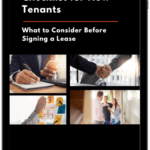When venturing into leasing commercial space, the type of lease you sign can significantly impact your business’s financial planning and day-to-day operations. This post will clarify the different types of leases available and how they can align with your business needs, providing you with the knowledge to make an informed decision.
Why Lease Types Matter
The Three Main Types of Commercial Leases
1. Net Lease
- Definition: In a net lease, the tenant pays not only the base rent but also a portion of the building’s operating costs. These costs include property taxes, insurance, and maintenance.
- Financial Implication: This type of lease typically offers a lower base rent, but you will incur variable costs, making budgeting a bit more complex. It is suitable for tenants who prefer having control over the maintenance and operation aspects of the property they are leasing.
2. Full-Service Lease
- Definition: This lease type is quite tenant-friendly. The landlord handles all property expenses, which are then included in the rent.
- Financial Implication: Costs are predictable, which aids in budgeting. It’s ideal for businesses that do not want the hassle of managing property expenses, providing a truly hands-off approach to property management.
3. Gross Lease
- Definition: Similar to a full-service lease, a gross lease simplifies budgeting by incorporating all property expenses into a flat rental fee.
- Financial Implication: This lease offers ease of budget management with stable payments, best for businesses that value simplicity and predictability in their financial planning.
Making the Right Choice
Selecting the appropriate lease type is not just about the immediate cost implications—it’s about aligning your lease with your long-term business strategy. Whether it’s stability in budgeting or flexibility in property management, the type of lease you choose can significantly influence your operational efficiency and financial health.
Key Considerations for Choosing the Right Lease
- Budget Flexibility: Depending on your financial strategy, you might prefer a lease that allows for predictable costs or one that could potentially lower overall expenses through active property management.
- Control vs. Convenience: Evaluate whether your business can benefit from having control over property maintenance (beneficial in a net lease) or if ease and convenience are more critical (a hallmark of full-service and gross leases).
- Long-Term Financial Planning: Consider the total costs over the lease term, not just the upfront monthly expenses. Some leases might seem cheaper on paper but can include fluctuating costs that could affect your long-term budgeting.
Conclusion
Choosing the right type of commercial lease can align strategically with your business operations and financial goals. Each lease type offers different benefits and challenges, and understanding these can help you select the best option for your business’s unique needs. Always consider consulting with a real estate professional to navigate the complexities of commercial leases effectively.




